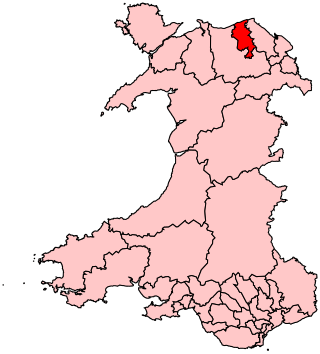
Sir Wayne David is a Welsh politician who served as Member of Parliament (MP) for Caerphilly from 2001 to 2024. A member of the Labour Party, he was Leader of the European Parliamentary Labour Party from 1994 to 1998. As a Member of the European Parliament, he represented South Wales from 1989 to 1994 and South Wales Central from 1994 to 1999.

Ynys Môn is a constituency of the House of Commons of the Parliament of the United Kingdom. It elects one Member of Parliament (MP) by the first past the post system of election. It is one of five 'protected constituencies' within the UK, with boundaries defined by the Parliamentary Constituencies Act 2020 to be to those of Isle of Anglesey County Council where there must be a whole number of MPs rounded up to the nearest whole number with these boundaries.

The Vale of Clwyd was a constituency of the House of Commons of the UK Parliament created in 1997. As with all seats it elected one Member of Parliament (MP) by the first past the post system at least every five years.

Bridgend is a constituency represented in the House of Commons of the UK Parliament since 2024 by Chris Elmore of Labour.

Caerphilly is a constituency centred on the town of Caerphilly in South Wales, represented in the House of Commons of the UK Parliament since 2024 by Chris Evans of the Labour Party.

Cardiff South and Penarth is a constituency created in 1983 represented in the House of Commons of the UK Parliament since 2012 by Stephen Doughty, a Labour Co-op MP. It was the largest constituency in Wales, with an electorate of 75,175 and one of the most ethnically diverse.

Clwyd South was a constituency of the House of Commons of the Parliament of the United Kingdom (Westminster). The constituency was created in 1997, and it elected one Member of Parliament (MP) by the first past the post method of election.

Clwyd West was a constituency of the House of Commons of the Parliament of the United Kingdom. It elected one Member of Parliament (MP) by the first past the post method of election. Its last MP was David Jones of the Conservative Party, first elected at the 2005 general election and who also served as Secretary of State for Wales from 4 September 2012 until 14 July 2014.

Islwyn was a constituency in Wales represented in the House of Commons of the Parliament of the United Kingdom. The area, historically known for coal-mining, had voted for Labour Party candidates since it was created effective at the 1983 general election. Islwyn's first Member of Parliament (MP) was Neil Kinnock, who represented it until he resigned from Parliament in 1995. Kinnock also served as Leader of the Labour Party and Leader of the Opposition from 1983 until 1992.

Llanelli is a constituency of the House of Commons of the Parliament of the United Kingdom. From 1918 to 1970 the official spelling of the constituency name was Llanelly. It elects one Member of Parliament (MP) by the first past the post system of election. Since 2005, it is currently represented by Nia Griffith of the Labour Party.

Merthyr Tydfil and Rhymney was a constituency represented in the House of Commons of the UK Parliament. It was established for the 1983 general election.

Ogmore was a constituency created in 1918, represented in the House of Commons of the UK Parliament.

Torfaen is a constituency in Wales represented in the House of Commons of the UK Parliament since 2015 by Nick Thomas-Symonds, a member of the Labour Party who also serves as the Paymaster General and Minister for the Cabinet Office under the government of Keir Starmer. It was established for the 1983 general election.

Wrexham is a parliamentary constituency centred on the city of Wrexham in the preserved county of Clwyd, Wales in the United Kingdom. It was created in 1918, and is represented in the House of Commons of the UK Parliament since 2024 by Andrew Ranger of the Labour Party.

Alyn and Deeside is a constituency of the Senedd. It elects one Member of the Senedd by the first past the post method of election. Also, however, it is one of nine constituencies in the North Wales electoral region, which elects four additional members, in addition to nine constituency members, to produce a degree of proportional representation for the region as a whole.

Delyn is a constituency of the Senedd. It elects one Member of the Senedd by the first past the post method of election. Also, however, it is one of nine constituencies in the North Wales electoral region, which elects four additional members, in addition to nine constituency members, to produce a degree of proportional representation for the region as a whole.

Ynys Môn is a constituency of the Senedd. It elects one Member of the Senedd by the first past the post method of election. Ynys Môn is also one of nine constituencies in the North Wales electoral region, which elects four additional members, in addition to nine constituency members, to produce a degree of proportional representation for the region as a whole.

The 2017 United Kingdom general election in Wales was held on 8 June 2017; all 40 seats in Wales were contested. The election for each seat was conducted on the basis of first-past-the-post.

The 2024 general election was held on Thursday, 4 July 2024. Thirty-two seats were up for election in Wales as the general election occurred after the recently completed boundary review took effect. The Labour Party remained the largest party in Wales, gaining six seats for a total of 27. Both Plaid Cymru and the Liberal Democrats made gains, taking them to four seats and one seat respectively. The Conservatives lost all thirteen seats they had held previously, leaving the party without Westminster representation from Wales for the first time since 2005.























